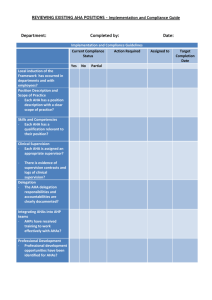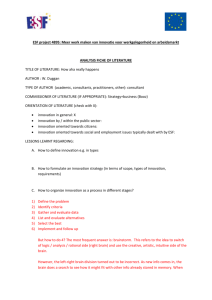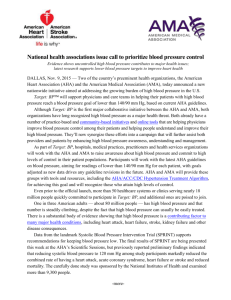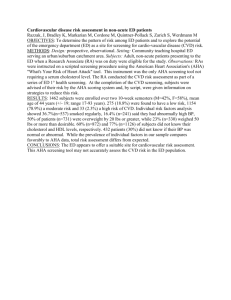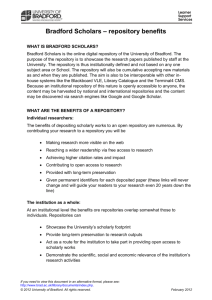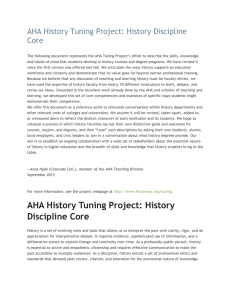Guideline for American Heart Association Data Sharing Plan
advertisement
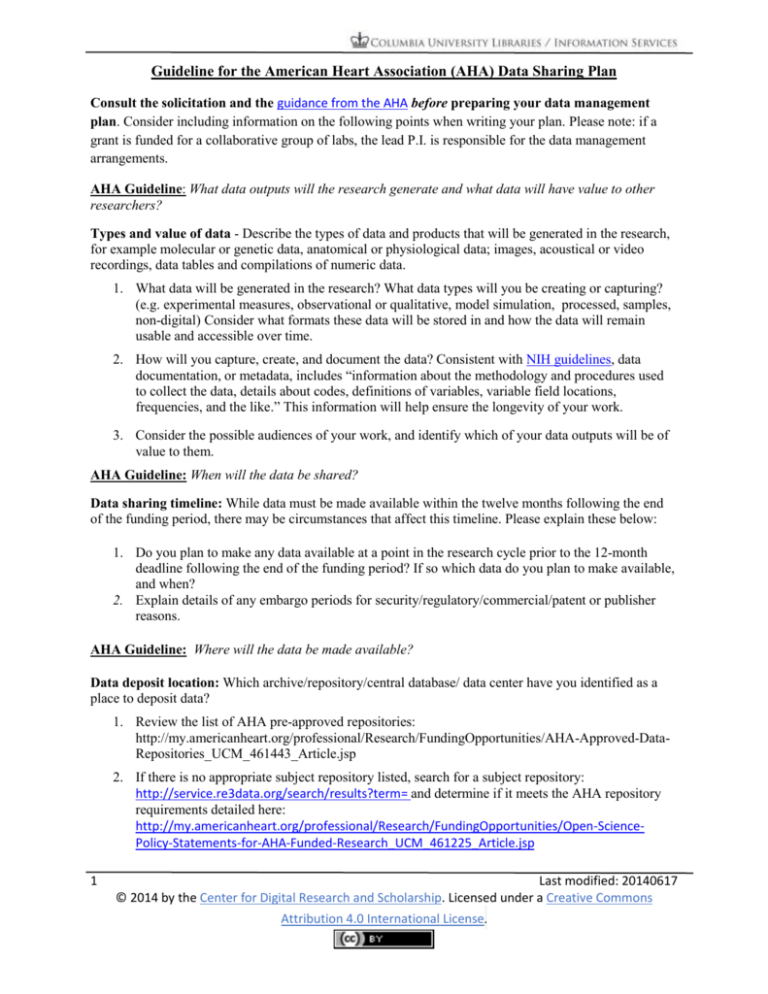
Guideline for the American Heart Association (AHA) Data Sharing Plan Consult the solicitation and the guidance from the AHA before preparing your data management plan. Consider including information on the following points when writing your plan. Please note: if a grant is funded for a collaborative group of labs, the lead P.I. is responsible for the data management arrangements. AHA Guideline: What data outputs will the research generate and what data will have value to other researchers? Types and value of data - Describe the types of data and products that will be generated in the research, for example molecular or genetic data, anatomical or physiological data; images, acoustical or video recordings, data tables and compilations of numeric data. 1. What data will be generated in the research? What data types will you be creating or capturing? (e.g. experimental measures, observational or qualitative, model simulation, processed, samples, non-digital) Consider what formats these data will be stored in and how the data will remain usable and accessible over time. 2. How will you capture, create, and document the data? Consistent with NIH guidelines, data documentation, or metadata, includes “information about the methodology and procedures used to collect the data, details about codes, definitions of variables, variable field locations, frequencies, and the like.” This information will help ensure the longevity of your work. 3. Consider the possible audiences of your work, and identify which of your data outputs will be of value to them. AHA Guideline: When will the data be shared? Data sharing timeline: While data must be made available within the twelve months following the end of the funding period, there may be circumstances that affect this timeline. Please explain these below: 1. Do you plan to make any data available at a point in the research cycle prior to the 12-month deadline following the end of the funding period? If so which data do you plan to make available, and when? 2. Explain details of any embargo periods for security/regulatory/commercial/patent or publisher reasons. AHA Guideline: Where will the data be made available? Data deposit location: Which archive/repository/central database/ data center have you identified as a place to deposit data? 1. Review the list of AHA pre-approved repositories: http://my.americanheart.org/professional/Research/FundingOpportunities/AHA-Approved-DataRepositories_UCM_461443_Article.jsp 2. If there is no appropriate subject repository listed, search for a subject repository: http://service.re3data.org/search/results?term= and determine if it meets the AHA repository requirements detailed here: http://my.americanheart.org/professional/Research/FundingOpportunities/Open-SciencePolicy-Statements-for-AHA-Funded-Research_UCM_461225_Article.jsp 1 Last modified: 20140617 © 2014 by the Center for Digital Research and Scholarship. Licensed under a Creative Commons Attribution 4.0 International License. 3. In the absence of a clear disciplinary repository you may choose to use Columbia University's institutional repository Academic Commons. Please note that it is an open repository. Here is some descriptive text to include in your plan: Deposit in Academic Commons, Columbia University’s institutional research repository, provides a permanent URL, secure replicated storage (multiple copies of the data, including onsite and offsite storage with verified checksum procedures), accurate metadata, a globally accessible repository and the option for contextual linking between data and published research results. Any file type may be deposited in Academic Commons. Files are available for public consumption and reuse, and for machine extraction. AHA Guideline: How will other researchers be able to access the data? Data access, sharing practices, and policies: 1. How will you make the data available? 2. Will access to your data be restricted in any way? How may researchers gain permission to access this data? 3. Do your prospective publishers place any restrictions on other avenues of publication? 4. How long will the original data collector/creator/principal investigator retain the right to use the data before opening it up to wider use? AHA Guideline: Are any limits to data sharing required – for example, to either safeguard research participants (e.g., HIPAA) or to gain appropriate intellectual property protection? 1. Are there ethical or privacy issues associated with the data? If so, how will these be resolved? How will you guard identifying information related to research subjects? See AHA guidelines for HIPAA compliance. 2. Are there superseding regulations, governmental or institutional, that limit the release of these data? 3. Will sharing these data violate previously established intellectual property rights? AHA Guideline: How will the grant recipient ensure that key datasets are preserved to ensure their long-term value? Data preservation: Describe plans for archiving data, samples, and other research products, and for preservation of access to them. 1. For each of the identified repositories or data storage solutions that is not one of the pre-approved data repositories, address the following: access and re-use policies, and long-term stability in terms of both finances and continuity plans. 2. What is the period of data retention? Reflecting on the previously stated value of data products, how long will/ should data be kept beyond the life of the project? 3. Are software or tools needed to access the data and how will these be archived? 4. Will hardcopy notebooks, group computer files, media recordings, instrument outputs, and physical samples be stored? 5. How will compliance with this plan be managed? Who will be responsible for data management in the research project? 2 Last modified: 20140617 © 2014 by the Center for Digital Research and Scholarship. Licensed under a Creative Commons Attribution 4.0 International License.
